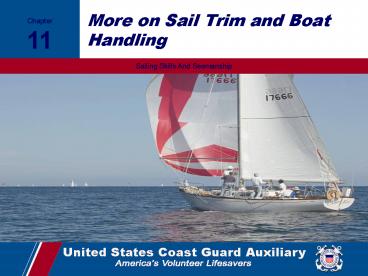More on Sail Trim and Boat Handling - PowerPoint PPT Presentation
1 / 27
Title:
More on Sail Trim and Boat Handling
Description:
Independent of the main sheet. Optionally connected to side ... Headsail sheets are in pairs and connected to the sail clew. Each sheet lead to a jib block ... – PowerPoint PPT presentation
Number of Views:154
Avg rating:3.0/5.0
Title: More on Sail Trim and Boat Handling
1
More on Sail Trim and Boat Handling
Chapter 11
2
More on Sail Trim and Boat Handling
- Part 2 Chapter 11
3
Lesson Objectives
- Fine tuning rigging
- Weather and lee helm
- Sail shape effects
- Head sail types
- Rigging for heavy winds
- Capsizing recovery
4
Standing Rigging Tuning
- Rake usually specified by boat manufacturer
- Rake sometimes altered slightly based on
experience - Boat feel may indicate need to alter tuning
- Inspection while under load give clues to needed
adjustments - Backstays are sometimes adjusted while under sail
- Marking turnbuckles w/ paint shows old adjustment
setting
5
Fractional Rigs
- Running Backstays sometimes adjusted on each tack
Reprinted with permission from How Boat Things
Work by Charlie Wing
6
Lee and Weather Helm
- Balanced helm sails without holding tiller
- Small weather helm preferred
- Helm balance - hull and sails (center of effort)
- Effected by wind strength and direction
7
Weather / Lee Helm Problems
- Can be poor boat design
- Poor selection of sail size and shape
- Centerboard set wrong
- Mast positioned incorrectly
- Sails set incorrectly
8
Mainsail Trim/Shape Summary
- Assume a boat is close hauled
- As wind subsides the draft (belly) should be
larger - As winds increase the belly must be smaller
- As winds increase it needs ability to spill
excessive wind power - All the mainsail adjustments interact to make the
best compromise
9
Mainsheet Effects on Sail
- Mainsail tightening causes sail to move towards
boat centerline - Causes downward boom force and improves windward
pointing - On choppy seas the main may be eased to keep wind
flowing over the sail
10
Mainsail Traveler
- Boom forces transferred transversely.
- Allows mainsail (dumping) in heavy winds.
11
Backstay Tensioner
- Allowing backstay to be slightly tightened or
loosened. - Loosened - better in light wind conditions.
- Tightening- improves the heavy wind performance.
12
Boom Vang
- Controls downward tension.
- Independent of the main sheet.
- Optionally connected to side- preventing an
accidental jibe.
13
Outhaul
- Regulates force pulling the mainsail clew aft.
- Regulates sail draft.
- Changes light wind / heavy wind performance..
14
Cunningham
- The Cunningham - cringle located about a ft.
above the mainsail tack. - Controls mainsail luff bagginess.
15
Headsails
- Headsails come in many sizes and weights
- Storm jibs
- Working jibs
- Jibs extending back from the forestay to the mast
(a 100 genoa) - Jibs or genoas can be much larger extending back
much further
16
Headsail Trim
- Headsail sheets are in pairs and connected to the
sail clew. - Each sheet lead to a jib block mounted on both
sides of the deck - Most boats employ a rail allowing a jib block to
be adjustable fore and aft, -- called a jib car - Jib block are adjusted to make sail fuller or
flatter to match wind conditions
17
Headsail Trim
18
Spinnaker
- A very large light weight sail for light wind
running/reaching applications - Often employs a pole to hold in position
- Often maddening to set, fly or lower
- Often dispatched for use and retracted from a
chute in the bow - Some are a generic design and others designed for
special applications
19
Sudden Bad Weather-Squalls
- Squalls arrive fast lasting a short time
- Put on life jacket
- Drop centerboard
- Drop all sails
- Secure loose materials
- Drop anchor
- Consider strapping crew to prevent being battered
(weak/elderly)
20
Stronger Winds
- Old conditions Sailing well with moderate winds
- New Conditions Winds/ waves increase
considerably - Actions
- If closed hauled- move to a slightly lower course
- Make mainsail flatter
- Straighten mast
- Loose the mainsheet slightly
21
Winds Continue Getting Stronger
- Consider changing from close-hauled to a reach
- Partially reef the genoa if equipped with roller
reefing - Partially reef the main
- Tighten topping lift to prevent boom from falling
22
Wind Very Stronger-Lowering Sails
- Douse the main or jib (genoa )
- Depends on boat design
- Try both options
- Helm feel determines best option
- Dousing both sails
- Best option when no sail control is possible
23
Knockdown
- Boat is heeled over but can recover
- Condition is fearful but not harmful
- Ballasted keel boats usually recover by
themselves
24
Capsize
- Determine if your boat is non-self righting
- Manage your boat in heavy weather accordingly
- If capsized, stay with boat- wear life jacket
- Account for all passengers
- Have an EPERB
25
Capsize Recovery
- Some boats capsize very easily
- With these tender boats- practice capsizing in
good weather and in standing water
26
Recovery Procedure
- Release the sheets
- Recover loose gear especially the rudder
- Use centerboard for leverage to right the boat
- There are tricks to aid recovery - practice will
disclose them - One trick After boat is upright, pull in
mainsheet slightly to give boat a tiny drive.
This prevents pulling the boat over yourself
while climbing inside.
27
Disabled Rudder
- Sailing w/o rudder is possible
- Adjusting jib and mainsail can head boat in any
direction - Backwind the jib to come about
- Paddle used as substitute rudder
- Shifting crew weight can affect steering































